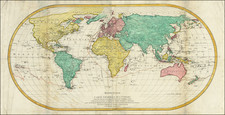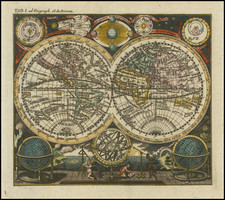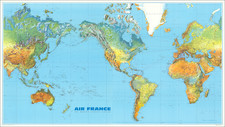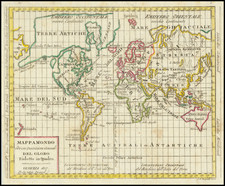Nice old color example of the rare Price-Willdey double hemisphere world map, first published in 1713 in London.
Fascinating double hemisphere map of the world, oriented with London at the center of Eastern Hemisphere and its antipode at the center of the Western Hemipshere.
The map shows California as a very large island, with all regions to the north marked 'parts unknown.' Iceland appears in the immediate proximity of Greenland. The western half of 'New Holland' is shown, along with the known coastline of Tasmania. The map is also one of the earliest maps to attempt to depict the wind directions at sea, with arrows and hachuring depicting wind directions and various notes around the world noting "calms and tornado" (in the Atlantic), Variable winds (blank areas of the sea in several places), and Shifting Winds (northwest of Australia). In the Indian Ocean, the map shows the monsoon trade winds, with notes as to the direction of the winds on a monthly basis.
The map is richly adorned across the top with allegorical images of the 4 continents as women and a decorative cartouche, surrounded by a different group of 4 allegorical images of women representing the 4 continents.
At the bottom, maps of the Sun (by Kircher) and the Moon (by Cassini) are shown, along with an array of instruments and trade goods pictured, made by Willdey, ranging from globes and microscopes to snuff boxes, watches and spectacles.
The map is dedicated "To his Grace Charles Duke of Shrewsbury Lord Chamberlain of the Household, and one of the Lord of Her Majtis most Honble Privy council Knight of the Garter, &c."
Willdey operated "the Great Toy Shop next to the Dog Tavern in Ludgate Street." While it has been suggested that Willdey simply reissued maps by Senex, Overton and several other map makers of the period, it is clear that this map is no mere re-issue. Willdey's maps are works of art, which includes finely engraved embellishments and a title cartouche, as well as an entertaining advertisement for his Great Toy Store.
This is the second state of the map, with prior state dated 1713. The map would later be sold to Thomas Jefferys, who would re-issued the map without the advertising at the bottom.
Charles Price (1679?-1733) was an engraver, instrument maker, and mapseller.
Price had been apprenticed to John Seller, famous mapmaker and father to Charles’ business partner, Jeremiah. In fact, Jeremiah and Charles were made free of the Merchant Taylors Guild on the same day, September 1, 1703. The two were already working together by then.
After breaking off with Seller, Price worked with John Senex (1705-10) and George Wildey (1710-13). He was still working in the 1720s, but was in Fleet Prison in 1731 for debt and died two years later.
George Willdey was an optical instrument maker. He also sold globes, maps, and toys at his shop in Ludgate Street. Born in Staffordshire, Willdey moved to London after the death of his father, where he was bound as an apprentice to John Yarwell, an optician. He was made free of the Spectaclemakers’ Company in 1702, when he began work as a journeyman.
A few years later, Willdey started in business with Timothy Brandreth, working under the sign of the Archimedes and Globe. They competed for business with Yarwell and other opticians, advertising their wares in trade cards and periodical advertisements.
Willdey and his wife, Judith, had five children, three of which survived to adulthood. Judith was a Huguenot, which allowed Willdey to create a wider network of artisans and craftsman. He expanded his stock to toys and household decorations, in addition to instruments. From 1709 he also sold printed goods, including maps and globes, which he sold in partnership with John Senex. Willdey purchased the copper plates for many maps, such as Christopher Saxton’s atlas of England and Wales.
We note the following addresses:
- From 1707 to 1713 he operated "At the Archemedes & Globe, Ludgate Street." sometimes described as "Archimedes and Globe next the Dog Tavern nearer Ludgate."
- In 1712 in partnership with Timothy Brandreth also advertised at Archimedes and Globe over against the Royal Exchange in Cornhill.
- In 1715 his location was described as "At the Great Toy and Print Shop, the corner of Ludgate Street, next to St. Paul's"
- 1718 to 1737 as "At the Great Toy, Spectacle, China-Ware, and Print Shop, the Corner of Ludgate Street near St. Pauls London."
In 1717, Willdey split with Brandreth and expanded his stock further to include coffee and tea, snuff, medicine, china, and cutlery. He sold these wares from his shop at Ludgate and St. Paul’s Churchyard. He aggressively advertised his business in hundreds of newspaper advertisements; he also adopted many advertising gimmicks, such as erecting a giant burning glass on the roof of his store. Willdey was a leader in the Spectaclemakers’ Company. His wife frequently helped with the business and eight of his fifteen apprentices were women, which was very unusual for either the instrument and toy trades at the time.
Willdey died in 1737, although he had been in declining health for years and had tried to pass the business to his son, Thomas. He was remembered in The Old Whig, or, the Consistent Protestant as the “most noted Toyman in Europe.” After his death, the shop was run by Judith along with a former apprentice, Susanna Passavant. Thomas, it seems, was not suited to business.
Willdey’s daughter, Jane Frances, married a Peter Fenoulhet, clerk of the entries in the Excise Office. Fenoulhet sued on behalf of their son over the mismanagement of the family business by Thomas. These lawsuits produced eleven inventories of household and commercial stock between 1730 and 1737, the only extant shop accounts from the London instrument trade from this period.














![[World] Air France --](https://storage.googleapis.com/raremaps/img/small/93647.jpg)